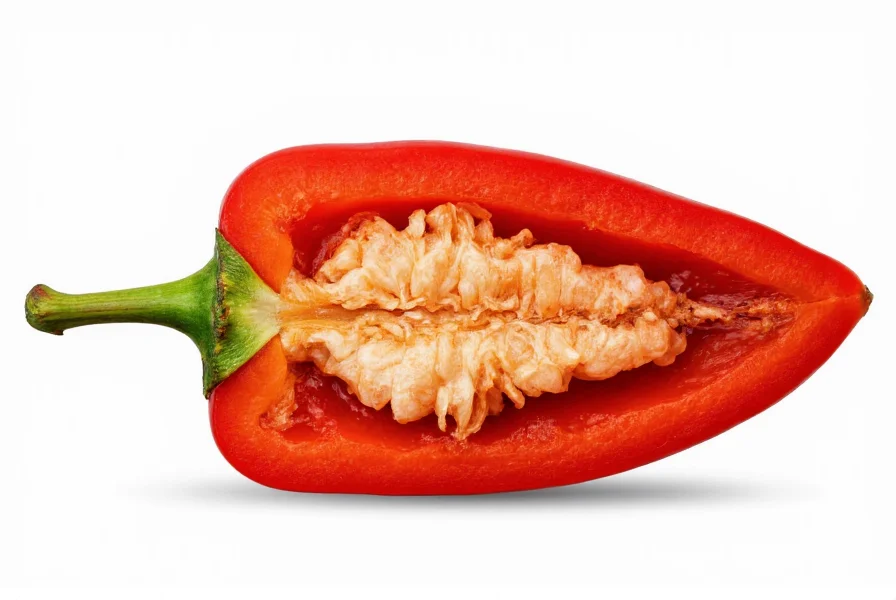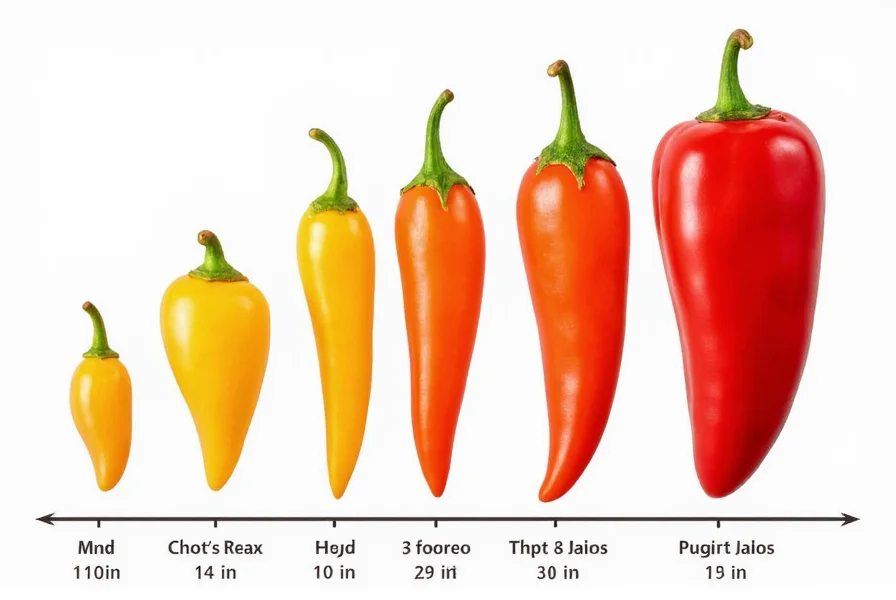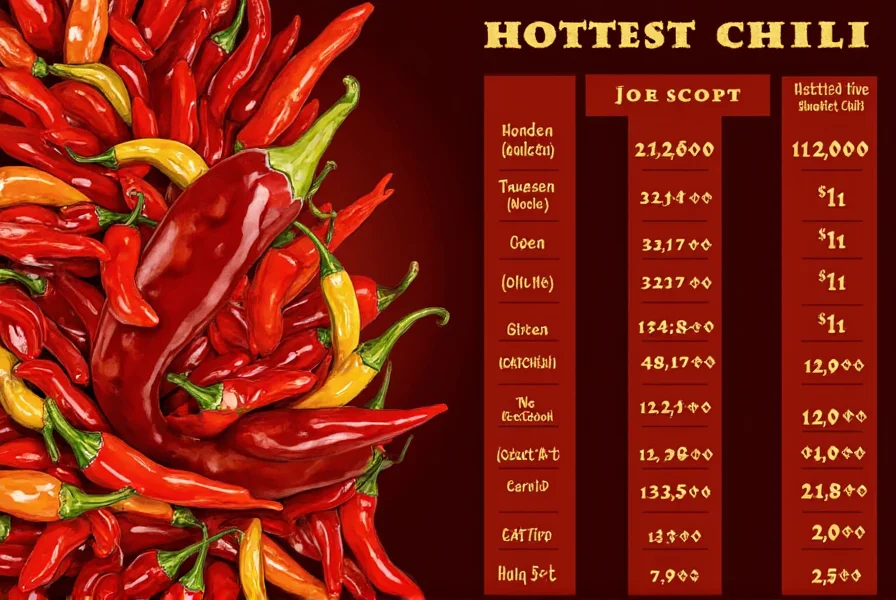The current hottest chili in the world is the Dragon's Breath pepper, measuring approximately 2.48 million Scoville Heat Units (SHU), though the Carolina Reaper (1.4-2.2 million SHU) remains the most widely recognized record holder officially verified by Guinness World Records. This comprehensive hottest chili chart details peppers from mild bell peppers (0 SHU) to extreme superhots, providing accurate Scoville scale measurements and practical context for each heat level.
Understanding pepper heat levels helps home cooks, chili enthusiasts, and culinary professionals safely incorporate these fiery ingredients into their dishes. The Scoville scale, developed by pharmacist Wilbur Scoville in 1912, remains the standard measurement for chili pepper pungency, though modern high-performance liquid chromatography (HPLC) provides more precise readings than the original organoleptic testing method.
How the Scoville Scale Works
The Scoville scale measures the concentration of capsaicinoids—the chemical compounds responsible for a chili's heat. Originally, the scale determined how many times a chili extract needed dilution in sugar water before the heat became undetectable to human testers. Today, HPLC testing calculates Scoville Heat Units (SHU) by measuring capsaicinoid concentration and multiplying by 15-16 to convert to Scoville units.
It's important to note that heat levels can vary significantly based on growing conditions, soil composition, climate, and even the specific part of the pepper. The placenta (white ribs inside the pepper) contains the highest concentration of capsaicin, while the seeds themselves contain minimal heat but often absorb capsaicin from the surrounding tissue.

Complete Hottest Chili Chart: Pepper Heat Levels from Mild to Extreme
| Pepper Name | Scoville Heat Units (SHU) | Heat Level Description | Common Uses |
|---|---|---|---|
| Bell Pepper | 0 SHU | No heat | Salads, stuffed peppers, raw consumption |
| Pepperoncini | 100-500 SHU | Mild | Pickled vegetables, Greek salads |
| Jalapeño | 2,500-8,000 SHU | Moderate heat | Salsas, nachos, poppers |
| Habanero | 100,000-350,000 SHU | Very hot | Hot sauces, Caribbean cuisine |
| Ghost Pepper (Bhut Jolokia) | 800,000-1,041,427 SHU | Extreme heat | Competitive eating, extreme hot sauces |
| Carolina Reaper | 1,400,000-2,200,000 SHU | World's hottest (verified) | Specialty hot sauces, chili challenges |
| Dragon's Breath | Approx. 2,480,000 SHU | Reported hottest (unverified) | Medical research (anesthetic properties) |
| Pepper X | 3,180,000 SHU | Reported new record holder | Experimental culinary applications |
Practical Interpretation of Heat Levels
Understanding what these numbers mean in practical terms helps avoid culinary disasters. Here's how different Scoville ranges translate to real-world heat experiences:
- 0-500 SHU: Bell peppers and sweet peppers. No detectable heat, safe for all ages.
- 500-5,000 SHU: Banana peppers, pepperoncinis. Mild warmth suitable for most palates.
- 5,000-15,000 SHU: Serrano peppers. Noticeable heat that builds gradually.
- 15,000-30,000 SHU: Tabasco peppers. Significant heat requiring caution.
- 30,000-50,000 SHU: Cayenne peppers. Intense heat that affects most people.
- 50,000-100,000 SHU: Thai bird chilies. Very hot, used sparingly in Southeast Asian cuisine.
- 100,000-350,000 SHU: Habanero and Scotch bonnet. Extreme heat requiring protective handling.
- 350,000-800,000 SHU: Fatalii and Red Savina habanero. Danger zone for most consumers.
- 800,000-1,500,000 SHU: Ghost peppers. Medical-grade heat requiring extreme caution.
- 1,500,000+ SHU: Carolina Reaper and beyond. Potentially dangerous without proper handling.

Safety Considerations for Handling Superhot Peppers
Working with extremely hot peppers requires proper safety precautions. Capsaicin, the compound that makes peppers hot, can cause severe irritation to skin and eyes. When handling superhot peppers like the Carolina Reaper or Ghost Pepper:
- Always wear nitrile gloves (latex won't protect against capsaicin)
- Avoid touching your face, especially eyes and nose
- Work in a well-ventilated area to avoid inhaling capsaicin particles
- Wash all surfaces and tools thoroughly after handling
- Have dairy products (milk, yogurt) nearby to neutralize heat if accidentally consumed
Medical professionals warn that consuming extremely hot peppers can cause temporary breathing difficulties, stomach distress, and in rare cases, more serious reactions. People with gastrointestinal conditions should exercise particular caution.
Evolution of the Hottest Chili Title
The title of world's hottest chili has changed hands several times in recent decades as breeders push the limits of pepper heat. The progression of officially recognized hottest peppers includes:
- 1994-2007: Habanero (up to 580,000 SHU)
- 2007-2011: Bhut Jolokia (Ghost Pepper) - 1,041,427 SHU
- 2012-2017: Trinidad Moruga Scorpion - 2,009,231 SHU
- 2013-present: Carolina Reaper - 1,400,000-2,200,000 SHU (Guinness World Records)
- 2017-present: Dragon's Breath - approx. 2,480,000 SHU (unverified)
- 2023: Pepper X - 3,180,000 SHU (claimed new record)
It's worth noting that many extremely hot peppers exist outside official verification. Breeders like Ed Currie of PuckerButt Pepper Company continue developing new superhot varieties, though the practical culinary value of peppers beyond 1 million SHU remains limited due to their extreme heat.
Culinary Applications Across the Heat Spectrum
Different heat levels serve distinct purposes in global cuisines. Understanding the hottest chili chart helps chefs and home cooks select appropriate peppers for specific dishes:
- Mild peppers (0-5,000 SHU): Form the base of many salsas, stuffed peppers, and vegetable dishes where flavor matters more than heat.
- Medium heat (5,000-30,000 SHU): Essential in Mexican, Tex-Mex, and Southwestern cuisines for authentic flavor profiles.
- Hot peppers (30,000-100,000 SHU): Feature prominently in Thai, Vietnamese, and other Southeast Asian cuisines.
- Very hot peppers (100,000-350,000 SHU): Used sparingly in Caribbean and West African cooking for intense heat.
- Superhot peppers (350,000+ SHU): Primarily used in hot sauces, chili challenges, and specialty products where extreme heat is the main feature.
When substituting peppers in recipes, consider both heat level and flavor profile. Habaneros offer tropical fruit notes, while Ghost Peppers deliver intense heat with smoky undertones. The Carolina Reaper combines fruitiness with extreme heat, making it valuable for certain hot sauce formulations.
Frequently Asked Questions About Chili Heat Levels
What is the most reliable hottest chili chart available?
The most reliable hottest chili chart comes from verified laboratory testing using high-performance liquid chromatography (HPLC). While many online charts exist, those referencing specific lab results from reputable sources like Guinness World Records or agricultural universities provide the most accurate Scoville measurements. The Carolina Reaper remains the officially recognized hottest pepper with verified readings between 1.4-2.2 million SHU.
How can I safely handle extremely hot peppers from the hottest chili chart?
To safely handle superhot peppers (350,000+ SHU), always wear nitrile gloves (not latex), work in a well-ventilated area, avoid touching your face, and wash all surfaces thoroughly afterward. Consider using safety glasses to protect your eyes from airborne capsaicin. If you experience skin irritation, apply milk or a specialized capsaicin removal product rather than water, which can spread the oil.
Why do Scoville ratings for the same pepper vary so much?
Scoville ratings vary due to growing conditions, soil composition, climate, water availability, and even the specific part of the pepper tested. The placenta (white ribs) contains the highest concentration of capsaicin. Two Carolina Reaper peppers from the same plant can differ by hundreds of thousands of SHU. This natural variation is why reputable sources provide ranges rather than single numbers for most peppers.
What's the difference between Scoville units and HPLC measurements?
The original Scoville scale relied on human testers to determine heat levels through dilution. Modern HPLC (high-performance liquid chromatography) testing measures actual capsaicinoid concentration in parts per million and converts to Scoville Heat Units by multiplying by 15-16. HPLC provides more precise, objective measurements without human subjectivity, though results are still reported in Scoville units for consistency with historical data.
Can eating the hottest peppers on the chart be dangerous?
Consuming extremely hot peppers (1,000,000+ SHU) can cause temporary but severe reactions including breathing difficulties, stomach distress, and in rare cases, more serious complications. While not typically life-threatening for healthy adults, superhot peppers can trigger dangerous reactions in people with certain medical conditions. Medical professionals advise against consuming peppers at the extreme end of the hottest chili chart without proper preparation and caution.











 浙公网安备
33010002000092号
浙公网安备
33010002000092号 浙B2-20120091-4
浙B2-20120091-4